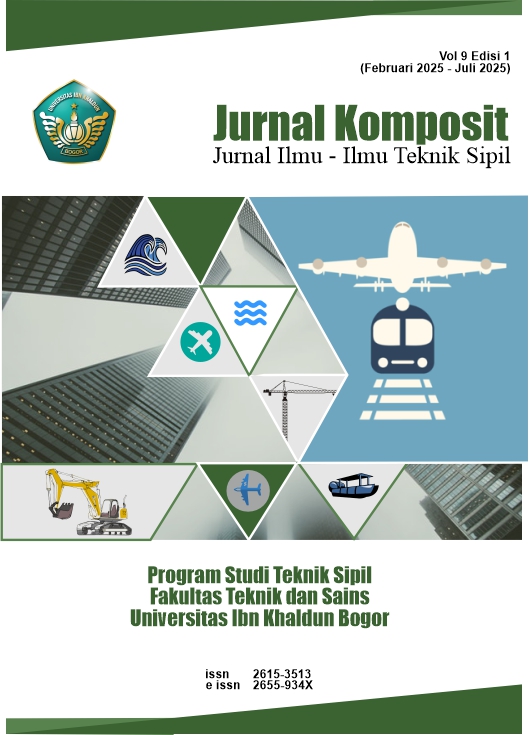Pengaruh Berat Volume terhadap Sifat Fisis dan Mekanis Bata Ringan CLC
DOI:
https://doi.org/10.32832/komposit.v9i1.16393Keywords:
bata ringan CLC, berat volume, foam agent, kuat tekan, sifat fisis dan mekanisAbstract
To reduce the weight of a structure for the purposes of lightweight construction on clay (soft) and peat, an innovation is required. Priority one is the self-weight of the structure. A method for reducing the weight of construction is to reduce the weight of the wall, particularly the wall made of red brick, which weighs 1500 kg/m3 s/d 2000 kg/m3, and cement brick, which weighs 950 kg/m3 s/d 1000 kg/m3. Then came the innovation of CLC lightweight concrete bricks, as the technology is so simple that small to medium-sized businesses can produce them. In addition to comparatively accessible raw materials, this technology is also more environmentally benign (green technology). CLC (Cellular Lightweight Concrete) is produced by combining cement, sediment, water, chemical admixture, and infill material consisting of air-produced foam such as micro-sized detergent foam (micro bubbles) or foam agent. Based on the research conducted with varying amounts of foam, the lightweight concrete brick weighs only 400 kg/m3 s/d 1200 kg / m3. When compared to red bricks and cement bricks, the weight of lightweight concrete bricks is nearly half that of red bricks and cement bricks. As a consequence of a decrease in the volume of the bataringan's weight, the pressure has diminished. And the batringan's physical and mechanical properties will also change
References
Ardyansyah, M. (2014). Study of the manufacture of lightweight brick CLC (celulular Lightweight Concrete) with high levels of coal fly ash as a partial substitution of cement, thesis. Busa Foamku. (n.d.). Retrieved from https://foamku.wordpress.com/tag/busa/
Kayyali, A. and Haque, M. N. (1997). A New Generation of Structural Lightweight Concrete. in Proceedings of the Third CANMET/ACI International Conference on Advances in Concrete Technology, ed. alhotra, V.M. ACI SP 171, Aukaland, New Zealand, (American Concrete Institute) 569-588. https://www.semanticscholar.org/paper/A-New-Generation-of-Structural-Lightweight-Concrete-Kayyali-Haque/59e136802315f298cacd96e36de52ecfc8c1dd7d
Kumawat, G., Maru, S., & Kumar Pandey, K. (2016). Cost comparison of RCC structure using heading CLC blocks with burnt clay bricks. International Journal of Advanced Research, 4(7). http://dx.doi.org/10.21474/IJAR01/1040
Kumawat, G., Maru, S. (2016). Analysis and Comparison of R.C.C. Structure Using CLC Block With Burnt Clay Bricks. International Journal of Engineering Research and General Science, 4(3). https://pnrsolution.org/Datacenter/Vol4/Issue3/65.pdf
Mulyono, T. (2003). Teknologi Beton, Yogyakarta: Penerbit Andi. https://pu.go.id/pustaka/biblio/teknologi-beton/B3197
Murdock, U, And Brook, K.M.. (1999). Bahan dan Praktek Beton, Edisi ke-4. Jakarta: Erlangga. https://library.jgu.ac.id/index.php?p=show_detail&id=4490
Nandi, S., Chatterjee, A., Samanta, P., & Hansda, T. (2016). Cellular concrete and its facets of application in civil engineering. Int. J. Eng. Res, 5(1), 37-43. http://dx.doi.org/10.17950/ijer/v5i1/009
Prakash, T. M. (2013). Properties of Aerated Concrete Blocks. International journal of scientific and engineering research, 4(1), https://www.ijser.org/researchpaper/properties-of-aerated-foamed-concrete-blocks.pdf
Hardianto, R., Sutandar, E., & Supriyadi, A. (2018). Studi Eksperimental Pembuatan Bata Ringan Foam Agent (Busa) dengan Variasi Pemakaian Air. JeLAST : Jurnal Teknik Kelautan , PWK , Sipil, dan Tambang, 5(1). https://jurnal.untan.ac.id/index.php/JMHMS/article/view/23914
Siram, K. K. B. (2012). Cellular Light-Weight Concrete Blocks as a Replacement of Burnt Clay Bricks. International Journal of Engineering and Advanced Technology (IJEAT), 2(2). https://www.ijeat.org/portfolio-item/b0887112212/
Putra, W. A. P. (2015). Comparison of compressive strength and tensile stress brick lightweight concrete with the addition of natural mineral zeolite sieve retained no. 80 (0.180 mm) and held by sieve No. 200 (0.075 mm), Thesis, Technical University of Brawijaya. Teknologi Beton - Google Books. (n.d.). Retrieved from https://www.google.co.id/books/edition/Teknologi_Beton/4ZZaEAAAQBAJ?hl=id&gbpv=1&dq=%E2%80%9CTeknologi+Beton%E2%80%9D.+Penerbit+ANDI.+Yogyakarta&pg=PT63&printsec=frontcover
SNI 7064:2014. (2014). Semen Portland Komposit, Badan Standarisasi Nasional. https://wancik.wordpress.com/wp-content/uploads/2007/06/sni-15-7064-2004_semen-portland-komposit.pdf
Sutandar, E., Supriyadi, A., & Andalan, C. P. (2018). Effect of Cement Variation on Properties of CLC Concrete Masonry Brick. MATEC Web of Conferences, 159, 01008. https://www.matec-conferences.org/articles/matecconf/pdf/2018/18/matecconf_ijcaet-isampe2018_01008.pdf
Sutandar, E. et al. (2021). Effect of Sand Gradient Variation on Properties of CLC Concrete Mansory Brick. The International Journal of Engineering and Science (IJES). 10(3), 13-21. DOI: http://dx.doi.org/10.9790/1813-1003021321
Sutandar, E., Supriyadi, A., & Ferry, J. (2022). Effect of Mineral Admixture on Physical and Mechanical Properties of CLC Concrete Masonry Brick. International Journal Of Scientific Advances. 3(1). https://www.ijscia.com/wp-content/uploads/2022/01/Volume3-Issue1-Jan-Feb-No.216-62-65.pdf
Downloads
Published
How to Cite
Issue
Section
License
Copyright (c) 2025 Jurnal Komposit: Jurnal Ilmu-ilmu Teknik Sipil

This work is licensed under a Creative Commons Attribution-NonCommercial-ShareAlike 4.0 International License.
Authors who publish with this journal agree to the following terms (Penulis yang mengajukan publikasi artikel telah menyetujui hal berikut):
- Through this publication, the author agree to submit the copyright of article writing to Jurnal Komposit: Jurnal Ilmu-ilmu Teknik Sipil. This copyright submission takes the form of, but is not limited to: reproduction of the article and parts therein, including photographic reproductions; distribution of articles through printed and electronic documents; and translation of articles(Bahwa melalui publikasi ini, hak cipta penulisan artikel diserahkan kepada Jurnal Komposit: Jurnal Ilmu-ilmu Teknik Sipil. Penyerahan hak cipta ini berupa, namun tidak terbatas pada: perbanyakan artikel dan bagian di dalamnya, termasuk reproduksi fotografi; penyebarluasan artikel melalui dokumen cetak dan elektronik; serta penterjemahan artikel).
- The authors agree to the terms of the Copyright Notice, according to Creative Commons Attribution-NonCommercial-ShareAlike 4.0 International License., which will apply to this article if and when it is published by Jurnal Komposit: Jurnal Ilmu-ilmu Teknik Sipil. (Para penulis setuju dengan ketentuan Pemberitahuan Hak Cipta, sesuai dengan Lisensi Internasional Creative Commons Attribution-NonCommercial-ShareAlike 4.0., yang akan berlaku untuk artikel ini jika dan ketika diterbitkan oleh Jurnal Komposit: Jurnal Ilmu-ilmu Teknik Sipil).

This work is licensed under a Creative Commons Attribution-NonCommercial-ShareAlike 4.0 International License.



.png)










